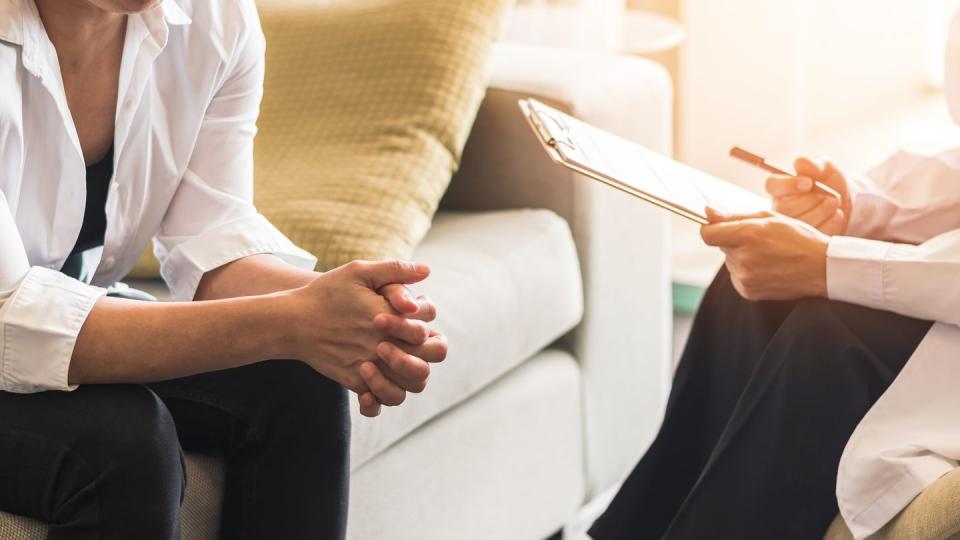Your Post-Period Cramps Could Indicate a Bigger Problem
Periods are a pain — there’s no denying that. Menstruation often arrives along with cramps, bloat, and cravings, and while most can expect this misery to endure for no more than a week, some might find that their discomfort lasts a little longer. Typically, you can expect cramps one or two days after your period, Dr. Peter Weiss, OB/GYN at Rodeo Drive Women’s Health Clinic, tells Woman's Day. But experiencing cramps after your period that last longer than a few days is definitely not normal, so if you've been writing off your after-period cramps as a regular part of your cycle, then it's time to address them.
“Because symptoms can mimic other conditions, it’s easy for women to 'normalize' their pain or think that it’s all in their head,” Dr. Rebecca Brightman, OB/GYN and founding member of Eastside Women's OBGYN Associates, tells Woman's Day. This "normalizing" of symptoms, however, can make it harder for someone to be diagnosed with a more serious condition. If you're someone who experiences more than a day or two worth of cramps after your period, then here are some reasons why this may be happening, as well as what you can do to address it.
What are these types of cramps called?
Painful menstrual cramps are known as dysmenorrhea, and there are two types of dysmenorrhea: primary and secondary. Primary dysmenorrhea is the name for the common menstrual cramps that may occur every cycle a few days before you get your period, and for most people, they're totally normal. Secondary dysmenorrhea, however, lasts longer than common menstrual cramps and is often caused by a reproductive system disorder or infection.
What does it mean if I have cramps after my period?

If you have pelvic pain that lasts for more than one or two days after your menstrual period ends, then chances are you're experiencing secondary dysmenorrhea — though it's important to note that secondary dysmenorrhea can occur at any time during your menstrual cycle. Cramps after your period can be caused by uterine fibroids, ovarian cysts, uterine or endometrial polyps, or pelvic inflammatory disease, all of which can be treated. Some of the more serious causes, however, include endometriosis and adenomyosis.
What do cramps after your period feel like?
Just like primary dysmenorrhea, secondary dysmenorrhea can come with a number of aggravating symptoms. Dr. Brightman says these include — but are not limited to — painful sex, painful bowel movement and urination, pelvic pain, bleeding or spotting between periods, heavy menstrual bleeding, bloating, and difficulty participating in day-to-day activities. However, you usually don’t have nausea, vomiting, fatigue, or diarrhea as a result of secondary dysmenorrhea.
What can cause cramps after your period?

Cramps after your period are usually caused by one of three things: a growth (such as uterine fibroids, ovarian cysts, or uterine or endometrial polyps), an infection (such as pelvic inflammatory disease), or a reproductive system disorder (such as endometriosis and adenomyosis).
Endometriosis occurs when tissue that normally lines the inside of your uterus starts growing outside of the uterus, causing painful cramps after your period, as well as pelvic pain and pain during sex. Similarly to endometriosis, adenomyosis occurs when there is tissue growth. However, this tissue — which is similar to the one lining the uterus — grows into the muscular walls of the uterus and sheds during menstruation. With adenomyosis, your uterus may become enlarged, which translates to having a tender pelvic area and a very heavy period. These disorders may even cause growths, like ovarian cysts.
Pelvic inflammatory disease (PID) is different in that it is an infection, which happens when sexually transmitted bacteria spread from the vagina to the uterus and other parts. It's not considered a sexually transmitted disease, but it's often caused by one.
How are cramps after your period treated?
Treatment for after period cramps depends on what is causing that pain. If your pelvic pain is caused by a growth, then you'll be glad to know that many cysts and polyps don’t require treatment other than regular observation by your healthcare provider. However, surgical intervention is necessary if the growth is cancerous, not going away on its own, or causing severe symptoms.
If your cramps are caused by PID, then you'll be able to receive treatment once you receive a diagnosis. Like most infections, PID can be treated with antibiotics, and often, your symptoms will improve before the infection even goes away. However, you should always finish your prescription to make sure the infection is fully treated.
Those who suffer from cramps due to endometriosis or adenomyosis will find that treatment is a little more difficult, as neither disease has a known cause or cure and only tend to dissipate when menopause begins. However, even though there isn't a cure, there are treatments to reduce the size of tissue growth and to relieve painful symptoms, such as non-steroidal anti-inflammatory drugs (NSAIDs) or hormonal birth control. For severe cases, a hysterectomy (which removes the endometrial tissue and the uterus) is also a possible treatment.
When should you visit a doctor for cramps?

You should always talk to your doctor about the symptoms that come with your period, especially if they seem abnormal. Additionally, Dr. Brightman recommends talking to your doctor, "if you’re unable to manage your menstrual symptoms with lifestyle changes and find that your symptoms are impacting your health and daily activities."
You Might Also Like


